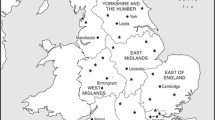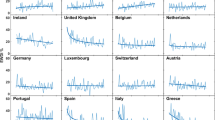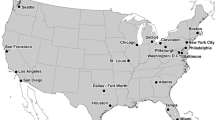Abstract
As cold weather is an ischaemic heart disease (IHD) risk factor, year-to-year variations of the level of IHD mortality may be partly determined by inter-annual variations in winter climate. This paper investigates whether there is any association between the level of IHD mortality for three English counties and the winter North Atlantic Oscillation (NAO), which exerts a fundamental control on the nature of the winter climate over Western Europe. Correlation and regression analysis was used to explore the nature of the association between IHD mortality and a climate index (CI) that represents the interaction between the NAO and temperature across England for the winters 1974–1975 to 1989–1999. Statistically significant inverse associations between the CI and the level of IHD mortality were found. Generally, high levels of winter IHD mortality are associated with a negative CI, which represents winters with a strong negative phase of the NAO and anomalously low temperatures across England. Moreover, the nature of the CI in the early stages of winter appears to exert a fundamental control on the general level of winter IHD mortality. Because winter climate is able to explain a good proportion of the inter-annual variability of winter mortality, long-lead forecasting of winter IHD mortality appears to be a possibility. The integration of climate-based health forecasts into decision support tools for advanced general winter emergency service and capacity planning could form the basis of an effective adaptive strategy for coping with the health effects of harsh winters.



Similar content being viewed by others
References
Ballaster F, Michelozzi P, Iniguez C (2003) Weather, climate and health. J Epidemiol Public Health 57:759–769
Bouma MJ, Poveda G, Rojas W, Chavasse D, Quinones M, Cox J, Patz J (1997) Predicting high-risk years for malaria in Colombia using parameters of El Nino southern oscillation. Trop Med Int Health 2:1122–1127
British Heart Foundation (2000) Coronary heart disease statistics: British Heart Foundation Statistics Database 2000. British Heart Foundation, Oxford
Collins KJ, Easton JC, Belfield-Smith H, Exton-Smith AN, Pluck RA (1985) Effects of age on body temperature and blood pressure in cold environments. Clin Sci 69:465–470
Donaldson GC, Keatinge WR (1997) Early increase in ischaemic heart disease mortality dissociated from and later changes associated with respiratory mortality and cold weather in south east England. J Epidemiol Community Health 51:643–648
Done SJ, Holbrook NJ, Beggs PJ (2002) The Quasi-Biennial Oscillation and Ross River virus incidence in Queensland, Australia. Int J Biometeorol 46:202–207
Ebi K, Kelsh M, Cher D, Exuzides K, Lau E (2000) Association of weather variables with hospital admissions for selected diseases to northern and southern California regions, 1983–1998. Epidemiology 11:195
Elwood PC (1993) Temperature and risk factors for ischaemic heart disease in the Caerphilly prospective study. Br Heart J 70:520–525
Epstein PR (2002) Climate change and infectious disease: storm weather ahead? Epidemiology 13:373–375
Eurowinter Group (1997) Cold exposure and winter mortality from ischaemic heart disease, cerebrovascular disease, respiratory disease and all causes in warm and cold regions of Europe. Lancet 349:1341–1346
Haines A, Patz JA (2004) Health effects of climate change. JAMA 291:99–103
Hales S, Weinstein P, Souares Y, Woodward A (1999) El Nino and the dynamics of vector-borne disease transmission. Environ Health Perspect 107:99–102
Healy JD (2003) Excess winter mortality in Europe: a cross country analysis identifying risk factors. J Epidemiol Public Health 57:784–789
Hurrell JW (1995) Decadal trends in the North Atlantic Oscillation: regional temperatures and precipitation. Science 269:676–679
Hurrell JW, Kushnir Y, Visbeck M (2001) The North Atlantic Oscillation. Science 291:603–605
Hurrell JW, Kushnir Y, Ottersen G, Visbeck M (2003) The North Atlantic Oscillation: climate significance and environmental impact. Geophys Monogr Ser 134:279
Jehn M, Appel LJ, Sacks FM, Miller ER III (2002) The effect of ambient temperature and barometric pressure on ambulatory blood pressure variability. Am J Hypertens 15:941–945
Junge MM, Stephenson BB (2003) Mediated and direct effects of the North Atlantic Ocean on winter temperatures in northwest Europe. Int J Climatol 23:245–261
Kalkstein L, Smoyer K (1993) The impact of climate change on health: some international implications. Experientia 49:969–979
Keatinge WR, Coleshaw SRK, Cotter F, Mattock M, Murphy M, Chelliah R (1984) Increases in platelet and red cell counts, blood viscosity, and arterial pressure during mild surface cooling: factors in mortality from coronary and cerebral thrombosis in winter. Br Med J 289:1404–1408
Keatinge WR, Donaldson GC, Bucher K (1997) Cold exposure and winter mortality from ischaemic heart disease, cerebrovascular disease, respiratory disease and all causes in warm and cold regions in Europe. Lancet 349:1341–1346
Kovats RS, Bouma MJ, Haines A (1999) El Niño and health. World Health Organization, Geneva
Kovats RS, Bouma MJ, Hajat S, Worrall E, Haines A (2003) El Niño and health http://image.thelancet.com/extras/02art5336web.pdf. Published online May 20, 2003
Lindgren E, Gustafson R (2001) Tick-borne encephalistis in Sweden and climate change. Lancet 358:16–18
Lloyd EL (1991) The role of cold in ischaemic heart disease: a review. Public Health 105:205–215
Marshall J, Kushnir Y, Battisti D, Chang P, Czaja A, Hurrell JW, McCartney M, Visbeck M (2002) North Atlantic climate variability. Int J Climatol 21:1863–1898
Mathieu PP, Sutton RT, Dong B, Collins M (2004) Predictability of winter climate over the North Atlantic European region during ENSO events. J Climatol 17:1953–1974
McGregor GR (1999) Winter ischaemic heart disease deaths in Birmingham, UK: a synoptic climatological analysis. Clim Res 13:17–31
McGregor GR (2001) The meteorological sensitivity of ischaemic heart disease mortality events in Birmingham, UK. Int J Biometeorol 45:133–142
McGregor GR, Bamzelis D (1995) Synoptic typing and its application to the investigation of weather air pollution relationships, Birmingham, UK. Theor Appl Climatol 51:223–236
McGregor GR, Watkin H, Cox M (2004) Temperature and ischaemic heart disease mortality seasonality relationships: implications for climate based health forecasting. Climatol Res 2004 (in press)
McMichaels AJ, Haines A, Sloof R, Kovats S (1996) Climate change and human health. World Health Organisation, Geneva
Mercer JB (2003) Cold—an underrated risk factor for health. Environ Res 92:8–13
Morgan MD, Morgan JM (1997) Weather and people. Prentice Hall, New Jersey
Neild PJ, Syndercombe-Court D, Keatinge WR, Donaldson GC, Mattock M, Caunce M (1994) Cold-induced increases in erythrocyte count, plasma cholesterol and plasma firbrinogen of elderly people without a comparable rise in protein C or factor X. Clin Sci 86:43–48
van Oldenborgh GJ, Burgers G, Klein Tank A (2000) On the El Niño teleconnection to spring precipitation in Europe. Int J Climatol 20:565–574
Pattenden S, Nikiforov B, Armstrong BG (2003) Mortality and temperature in Sofia and London. J Epidemiol Community Health 57:628–633
Patz JA, Kovats RS (2002) Hotspots in climate change and human health. Br Med J 325:1094–1098
Rogot E, Padgett SJ (1976) Associations of coronary and stroke mortality with temperature and snowfall in selected areas of the United States, 1962–1966. Am J Epidemiol 103:565–575
Saunders MA, Qian BD (2002) Seasonal predictability of the winter NAO from north Atlantic sea surface temperatures. Geophys Res Lett 29:2049 DOI 1029/2002GL014952
Simonsen L, Clarke MJ, Williamson GD, Stroup DF, Arden NH, Schonberger LB (2001) The impact of influenza epidemics on mortality: Introducing a severity index. Am J Public Health 87:1944–1950
Stephenson DB, Pavan V, Bojariu B (2000) Is the North Atlantic Oscillation a random walk? Int J Climatol 20:1–18
Thomson M, Indeje M, Connor S, Dilley M, Ward N (2003) Malaria early warning in Kenya and seasonal climate forecasts. Lancet 362:580
Woodhouse PR, Khaw K, Plummer M (1993) Seasonal variation of blood pressure and its relationship to ambient temperature in an elderly population. J Hypertens 11:1267–1274
Yarnal B (1993) Synoptic climatology in environmental analysis. Wiley, Chichester, p 256
Acknowledgements
Pre-processing of the meteorological and mortality data into monthly values was completed by Dr Michelle Cox, University of Birmingham, who is funded under the UK Natural Environment Research Council’s “Coupled Ocean and Atmospheric Processes and European Climate (COAPEC): Bridging the Gap Between Science and Society” programme grant NER/T/S/2002/00155, project title “Climate Information for the Health Sector”.
Author information
Authors and Affiliations
Corresponding author
Rights and permissions
About this article
Cite this article
McGregor, G.R. Winter North Atlantic Oscillation, temperature and ischaemic heart disease mortality in three English counties. Int J Biometeorol 49, 197–204 (2005). https://doi.org/10.1007/s00484-004-0221-7
Received:
Revised:
Accepted:
Published:
Issue Date:
DOI: https://doi.org/10.1007/s00484-004-0221-7




